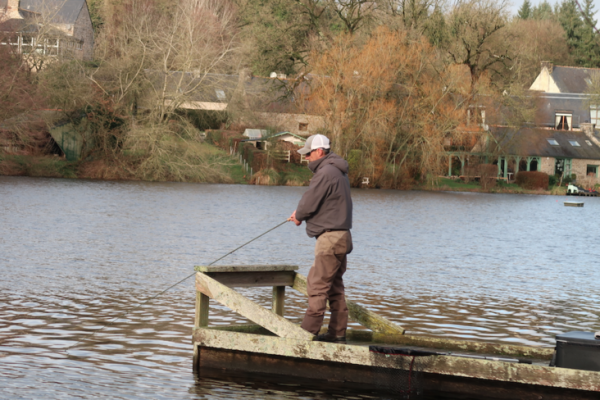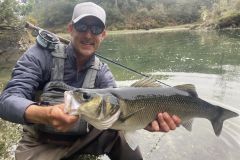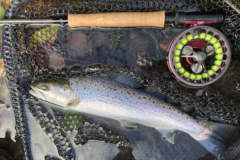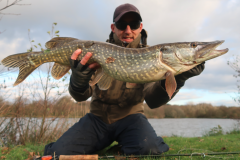Fishing tackle: rod, reel and line sets
Reservoir fishing generally requires the use of several rod and reel assemblies on which numerous lines are mounted to fish from the surface to the bottom.
So you need several rods and reels. With 3 rods, it's possible to juggle the different techniques, but some competitors or regular reservoir anglers may have 6, 7 or 8 rods or even more! And yes, in this case, the angler has one rod fitted with one or two floating lines, one or two intermediate lines (slow to fast) and two to three sinking line rods (S3 to S5 or same density but different set-up).
The idea is to have a rod set up for every type and depth of fishing and/or technique, but let's start with the bare minimum.

- A 9 to 10-foot rod with 6 or 7 power floating silk is used for surface fishing with various floating imitations (tipula, chiro, sedge, terrestrials, etc.).
This same line will also allow you to fish slightly below the surface, or above weed beds, whether nymphing, drowning or streamer fishing, but also washing line or "clothesline" techniques, for example.
- A 9- to 10-foot, 7-power rod with an intermediate line for fishing between two waters with a variety of flies, including chiro, drowned and streamer flies, as well as underwater "suspending" flies in water depths of 1 to 1.5 m or a little more.
- A 9- to 10-foot rod with a 7 or 8 power rating for fishing with sinking lines. For this type of fishing, there are several line densities that allow you to sink more or less quickly. The higher the number, the faster the line sinks to the bottom. We have S3, S5, S7. They are ideal for streamer fishing, but especially for bottom fishing with boobies, blobies and FABs.
With these three sets, it is possible to cover a good part of the water layers and techniques that can be used in reservoirs, but important choices will have to be made at the start of the fishing trip for the set-up of each rod, and then adapted to the conditions and activities of the fish.
Of course, the angler who has more rods will be able to juggle silk densities and techniques more quickly and thus be more quickly adapted to the fishing of the moment.

Preparing your fly boxes
Once again, you'll have to make the right choices in terms of techniques and therefore flies to use.
Before the start of the season, it's a good idea to take stock of what you own and check that nothing is missing, including the "classics" that you absolutely must have and those with which you fish regularly and bring home fish.
If you're a fitter, you'll be able to fill in the gaps. If you're not, you can buy what you need to replenish your boxes in stores or on the Internet.
It's also always a good idea to glean information from magazines, websites or even videos on the subject, to keep up to date with the latest developments.
In fact, there are so many techniques and models of flies for the reservoir that it is still necessary from time to time to inform oneself and test "novelties" or models that are commonly used by seasoned anglers, whether they are competitors or regular and therefore expert anglers.

However, you must have at least the following items in your boxes:
An assortment of dry flies for use at the start of the season, particularly in October, but also later in the season.
Tipules are a must-have mainly in early autumn, but also floating chiros such as shipman buzzer, emerger and others. All emerging chiro models are important to have in different sizes and colors. You can also add large sedges, particularly deer, and a few black terrestrials, which are all-purpose.
It's also a good idea to fish drowned, especially on windy days and when the fish are close to the surface. Simple, predominantly black patterns with occasional coloured tags such as Viva, black zulu, etc. are timeless and often bring in a few fish. Drowned tipules or daddy longlegs are also excellent, especially in September and October. Gallows-mounted cormorants are also a safe bet.
A few light nymphs for sight-fishing and small helmeted nymphs in ORL or pheasant tail are always interesting in reservoirs. But it's the chironomid nymphs above all that you need to have in your tackle box, as they represent an important part of the trout diet in all lakes and reservoirs.
Streamer fishing is still often the most popular choice. Freshly-introduced trout respond well to this type of fly. Very colorful flies are excellent for fresh fish, and then you'll have to go back to white, black, olive and brown patterns for the more educated.
Sparkler, wooly bugger, catwhisker, tadpole, montana... are all classics.
And let's not forget all the other flies available for reservoir fishing, especially in mid-winter, such as blobs, blobies, boobies, FAB, Egg fly, etc., which are sometimes prohibited in certain reservoirs but are so effective when the fish are stuck to the bottom. Some flies can also be used to fish with the washing line technique.

Practical tank equipment
When you're a regular reservoir angler, there's some very practical equipment that's good to have in your possession.
It's essential to have a landing net to quickly dry your fish and release it in the best conditions. Trout are often large and very combative. A landing net is an invaluable aid. Long-handled landing nets are sometimes necessary when the banks are steep or marshy. A landing net is often compulsory in reservoirs.
Another handy tool is a rod holder, so you can take several mounted rods with you. You can buy one on certain websites or in stores (more rare), but it's also possible to make one yourself. Tutorials are available on the Internet.

A waterproof bag or waterproof storage box for your equipment will keep everything close at hand. Spools, fly boxes, threads, pliers, etc. will be well stored and protected from the rain.
A measuring board, or tape measure, can also be used to measure your fish if you want to know their size. It's important to take measurements quickly, keeping your fish out of the water for as short a time as possible.
We wish you a good start to the reservoir season and look forward to hearing from you soon.

 /
/ 








